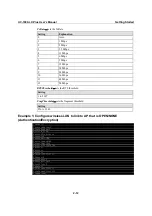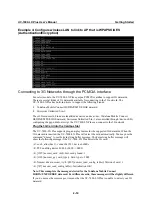
UC-7400-LX Plus User’s Manual
Introduction
1-3
The UC-7400-LX Plus’s built-in Flash ROM is partitioned into Boot Loader, Linux Kernel, Root
File System, and User Root File System partitions.
In order to prevent user applications from crashing the Root File System, the UC-7400-LX Plus
uses a specially designed Root File System with protected configuration for emergency use. This
Root File System comes with serial and Ethernet communication capability for users to load the
Factory Default Image file. The user directory saves the user’s settings and applications.
To improve system reliability, the UC-7400-LX Plus has a built-in mechanism that prevents the
system from crashing. When the Linux kernel boots up, the kernel will mount the root file system
for read only, and then enable services and daemons. During this time, the kernel will start
searching for system configuration parameters via rc or inittab.
Normally, the kernel uses the Root File System to boot up the system. Since the Root File System
is protected and cannot be changed by the user, this provides a “safe” zone.
For more information about the memory map and programming, refer to Chapter 5,
“Programmer’s Guide.”
Journaling Flash File System (JFFS2)
The User Root File System in the flash memory is formatted with the
Journaling Flash File
System (JFFS2)
. The formatting process places a compressed file system in the flash memory,
transparent to the user.
The Journaling Flash File System (JFFS2), which was developed by Axis Communications in
Sweden, puts a file system directly on the flash, instead of emulating a block device. It is designed
for use on flash-ROM chips and recognizes the special write requirements of a flash-ROM chip.
JFFS2 implements wear-leveling to extend the life of the flash disk, and stores the flash directory
structure in the RAM. A log-structured file system is maintained at all times. The system is always
consistent, even if it encounters crashes or improper power-downs, and does not require
fsck
(file
system check) on boot-up.
JFFS2 is the newest version of JFFS. It provides improved wear-leveling and garbage-collection
performance, improved RAM footprint and response to system-memory pressure, improved
concurrency and support for suspending flash erases; marking of bad sectors with continued use of
the remaining good sectors (which enhances the write-life of the devices), native data compression
inside the file system design, and support for hard links.
The key features of JFFS2 are:
Targets the Flash ROM directly
Robustness
Consistency across power failures
No integrity scan (fsck) is required at boot time after normal or abnormal shutdown
Explicit wear leveling
Transparent compression
Although JFFS2 is a journaling file system, this does not preclude the loss of data. The file system
will remain in a consistent state across power failures and will always be mountable. However, if
the board is powered down during a write then the incomplete write will be rolled back on the next
boot, but writes that have already been completed will not be affected.
Additional information about JFFS2 is available at:








































